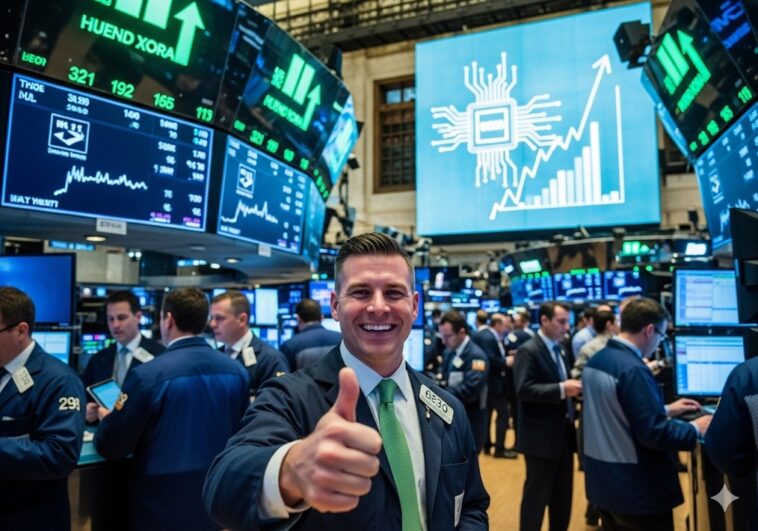US stocks took off on Thursday, bouncing back from earlier concerns as the Federal Reserve hinted at a more aggressive approach to rate cuts. Leading the way was the tech-heavy Nasdaq Composite, which received a significant boost from an unexpected partnership between two chip industry giants.
The Nasdaq Composite (^IXIC) surged by a full 1%, while the broader S&P 500 (^GSPC) rose 0.5%, reaching new record highs. Even the Dow Jones Industrial Average (^DJI), which isn’t as tech-focused, saw a solid 0.3% increase, indicating that this rally was more widespread than just a few standout stocks.
A Lifeline for Intel
The big news of the day, without a doubt, was the incredible jump in Intel (INTC) shares. The struggling chipmaker saw its stock soar by over 25% in early trading after Nvidia (NVDA) revealed a jaw-dropping $5 billion investment. For a company that has been trying to regain its footing, this is a huge vote of confidence—and a much-needed boost.
“This is a total game-changer for Intel,” remarked Mark Harrison, a senior analyst at Capital Market Advisors. “It’s not just about the cash; it’s the endorsement from a market leader like Nvidia. This could really reshape how investors see Intel’s long-term potential.”
The news sparked excitement across the entire semiconductor sector, reminding us once again that in this market, the right partnership can be just as crucial as the financials.
The Fed’s Balancing Act
The recent rally in the broader market followed the Federal Reserve’s decision to lower interest rates by a quarter-point on Wednesday. While this move was largely anticipated, investors were a bit cautious after Chair Jerome Powell’s careful remarks. He pointed out that there’s “no risk-free path” ahead, clearly highlighting the delicate balance the Fed is trying to maintain between high inflation and a softening labor market.
However, it seems the market is more focused on the Fed’s “dot plot,” which now indicates two additional rate cuts in 2025. This is more than the one or two cuts that many analysts had predicted, sparking speculation that the Fed is genuinely committed to supporting the economy.
On a mixed note, the latest jobless claims data released on Thursday showed a slight decrease in filings, which seems positive at first glance. But digging deeper reveals a slowdown in both worker demand and supply, hinting that the labor market might be losing momentum. It’s a classic scenario of good news and bad news happening simultaneously, something that investors appear to be getting used to.
Corporate Earnings and Global Tensions
Let’s take a look beyond the Fed and the ongoing chip wars, as corporate news is also grabbing attention. FedEx (FDX) is gearing up to share its quarterly results after the market closes, and analysts are preparing for some tough news. The general consensus is that the shipping giant’s profits have taken a hit due to President Trump’s recent move to end a crucial tariff exemption for low-value imports from China.
On the geopolitical side, Trump is currently in the UK for a state visit. He enjoyed a dinner with some of the biggest names in tech and finance at Windsor Castle and is scheduled to meet with Prime Minister Keir Starmer to discuss a range of topics, from AI to digital assets. These discussions highlight the increasing focus on strengthening relationships in the tech industry, with companies like Microsoft and Nvidia already committing to new investments.
This intricate interplay between politics and technology is creating a new landscape for investors: the factors influencing the market are no longer just local. As governments vie for technological supremacy, companies are emerging as significant diplomatic players in their own right.
The Road Ahead
All in all, it was a day filled with two narratives: one about a recovering market supported by a friendly Fed, and the other about a remarkable partnership that transformed an entire sector. Looking ahead, the big question is whether these trends will hold up. Can the Fed’s gentle approach really keep the market steady if the economic indicators take a downturn? And perhaps more crucially, will the collaboration between Nvidia and Intel lead to a more united and innovative future in the chip industry?



